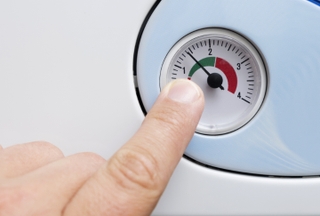A guide to boiler pressure
09 July 2020

Boiler pressure is an essential part of all central heating systems, and it helps to keep your home warm. It’s important to understand that your boiler’s pressure levels can vary. In our guide you’ll find out how to read your pressure gauge, and what you can do if your boiler’s pressure is too low or high.
What is boiler pressure?
Boiler pressure refers to the pressure of hot water running in your sealed central heating system. It’s essential to make sure that hot water is able to run through your system without any problems between your central heating system and radiators. It’s worth noting that boiler pressure is different from water pressure. Water pressure refers to the pressure of the water flow from the mains to your taps.
What pressure should my boiler be?
In most cases, boiler pressure varies between different models, so the correct pressure won’t be precisely the same. Most central heating systems operate within the range of 1 and 2 bars, which is approximately 14 and 29 pounds per square inch (psi). It’s important to check your instructor’s manual to find out if this is the case for your system.
When checking your boiler pressure, the first port of call should be your pressure gauge. For most boiler models, it’s located on the front of the unit. If not, it can sometimes be found on the underside of your unit. On an analogue pointer display, your boiler pressure will be displayed by a little needle that points towards either a red or green/blue section to indicate the level of pressure.
Low boiler pressure
If your boiler’s pressure is low, this could be a sign that there’s a loose seal on pipes and valves or there is a water leak within the system due to bleeding from a radiator. For most boiler models, anything below 1 bar is considered low pressure. It’s important to check your manual to find out the recommended pressure range. Low boiler pressure can cause your unit to become less energy efficient, and it may even prevent hot water from reaching your taps or central heating.
High boiler pressure
If the pressure gauge is above 1.5 bar, then your boiler’s pressure is high. This could simply be the result of you having recently topped up the pressure, but if it’s not, it could be caused by the excess water demand needed for heating your home. An indicator if this problem might be your valves becoming loose, and your radiators being noisy. High boiler pressure can create a strain on your heating systems, and prevent them from working.
How to fix boiler pressure issues?
The good news is that in most cases you can fix your boiler by yourself. If your boiler’s pressure is too low, turn it off so it has time to cool down. Then, locate the filling loop and loosen the valve. Once the valve is opened, pressure in the boiler will increase. Make sure to keep an eye on your pressure gauge, filling the unit until it reaches 1 bar. After this, turn the valves back to their original position. This will stop the flow of water and stabilise your boiler pressure.
If you’re experiencing issues re-pressurising or depressuring your system, or you find that your unit is noisy, you should contact your engineer who can replace essential parts such as pressure valves and gauges. If these issues are still not resolved, your boiler may need to be removed and replaced by a Gas Safe registered engineer.
In most cases, resolving boiler pressure will be something you can do yourself, but don’t be afraid to ask for professional advice or check with your boiler manufacturer if you need further guidance.